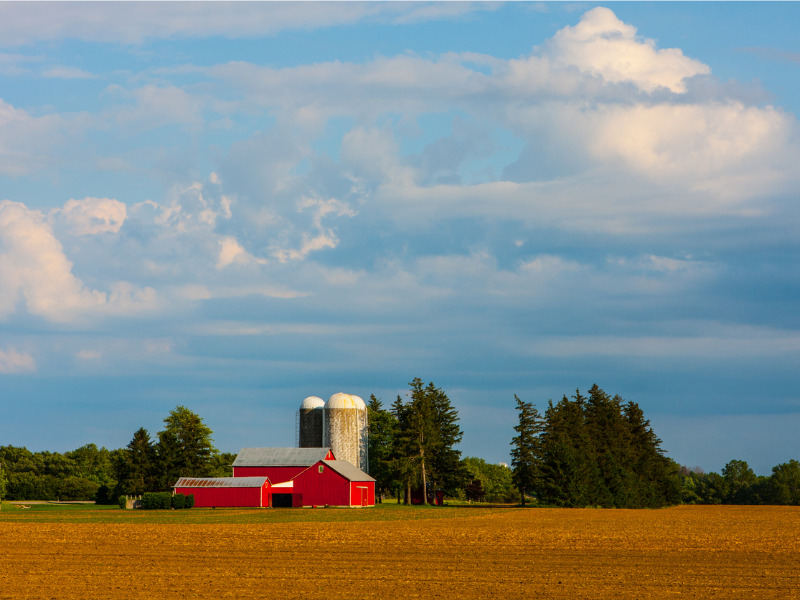Will building code changes affect farm fire severity?

With changes from the National Building Code of Canada (NBC) in the process of becoming law in Ontario next spring, farm insurance experts are raising concerns that the maximum barn size restriction will be removed and Ontario’s Fire Code (OFC) will still not apply to farm buildings in certain instances.
The National Farm Building Code of Canada (NFBC) currently restricts the size of farm buildings in the country to 5,000 square metres, or roughly 52,000 square feet. But if the restrictions are removed, this could increase the sizes of Canadian farm buildings, which could impact the severity of fire losses in the agricultural sector.
“You can go as big as you want, and that’s going to be the challenge,” said Randy Drysdale, assistant vice president, loss control, technical development at Farm Mutual Re. “It could also be the new normal.
“Are we now going to see really, really large farms?” Drysdale asked. “I think the answer is yes.”
Drysdale was speaking during the Farm Fire Summit held virtually and in-person Wednesday at the Farm Mutual Re office in Cambridge, Ont.
Ken Worsley, chief operations officer at Nova Mutual Insurance Company, added that some of the code changes could have an unintended affect on the affordability and availability of insurance capacity for larger agricultural operations. “These farms are remote with little to no water supply to fight these fires and of frame construction, exacerbating the severity of a potential fire.”
iStock.com/davidfillion
The only thing that could impede the size of the build now would be requirements for minimum separation distances, said Alice Van Vught, a training specialist at The Commonwell Mutual Insurance Group.
For example, Ontario farmers planning a new build or adding to an existing farmstead need to take distances into account for snow and wind control, ventilation, disease control, and separate residences for noise and odour control.
The NFBC was published in 1995 and there have been no substantive updates since, Van Vught said. The Canadian Farm Builders Association’s position is that building codes are not keeping up with requirements in the farming industry, as buildings are increasing in size, complexity and technological advancements.
But the new proposed NBC will incorporate more than 280 technical changes. Among them, OFC will apply in certain instances to the new farm buildings greater than 600 square metres. “This would include OFC compliance on early detection and fire suppression systems,” Van Vught said.
She acknowledged there are smaller and mid-sized barns that would benefit from changes to the NBC. They will still be able to use the NFBC for now, although it is anticipated the NFBC will eventually be phased out.
The proposed new changes will also involve repeat risk assessments on farm properties as it relates to electrical and mechanical systems, and annual audits on fire prevention systems. Storage, identification and fire safety requirements for hazardous goods would be included.
“Electrical inspections are going to be mandatory, and maintenance of ventilation equipment…is going to be enforced on an ongoing basis,” Van Vught added. “So, these are some really good changes for the better that are going to help.
“We’re really setting ourselves up well for significantly reducing the risks associated with [agriculture] buildings because we want to ensure safe and sustainable farm operations.”
Every farm building will also be classified according to its major occupancy as belonging to one of the 4 Divisions of Group G:
Division 1 – High-hazard agricultural operations
This includes operations with highly combustible and flammable or explosive materials, livestock housing with below-floor manure storage, feed mills, and grain elevators.
Division 2 – Agricultural occupancies not elsewhere classified in Group G
Animal exercise and training facilities, livestock operations, feed storage, and machinery storage.
Division 3 – Greenhouse agricultural occupancies
Where plants are grown in a building or part thereof that is primarily constructed of roofs and walls designed to transmit natural light.
Division 4 – Agricultural occupancies with no human occupants
Occupancies not intended to be occupied by persons under normal use and generally used for the storage of agricultural materials and by-products; biomass; digesters; and silos.
Feature image by iStock.com/DeepInsights





